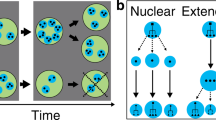Abstract
Changes in a typology of family structures incorporating household size and female labor force participation are decomposed using the 1969–78 years of the Panel Study of Income Dynamics. Among other things, racial, cohort, and educational differences result in: (1) a decline in large families regardless of mother's work status, due principally to racial effects; (2) a slight rise in the labor force entry of women from older cohorts; and (3) a substantial rise in the number of non-working mothers in small families, mainly from the younger cohorts. The discussion focuses on the advantages and implications of the use of the family rather than the individual as the unit of analysis in this type of research.
Similar content being viewed by others
Bibliography
AnscombeF. J. and J.Tukey: 1963, ‘The examination and analysis of residuals’, Technometrics 5, pp. 141–160.
Avioli, Paula Smith: 1981, ‘The employment decision of married mothers of infants’, paper prepared for the Workshop on Life-Course Research with Panel Data, sponsored by the Social Science Research Council's Committee on Life-Course Perspectives and Aging (Elkridge, Maryland).
BowenW. G. and T. A.Finegan: 1969, The Economics of Labor Force Participation (Princeton University Press, Princeton).
BumpassL. L. and J. A.Sweet: 1980, Patterns of Employment Before and After Childbirth (U.S. Department of Health and Human Services, Hyattsville, Maryland).
CainGlen G.: 1966, Married Women in the Labor Force (University of Chicago Press, Chicago).
CramerJames C.: 1980, ‘Fertility and female employment: problems of causal direotion’, American Sociological Review 45, pp. 167–190.
DavisJames A.: 1974, ‘Concepts and procedures for constructing odds ratio models for causally ordered, multivariate contingency tables’, Studies in Social Change Since 1948, National Opinion Research Center Report 1 (127A), pp. 35–92.
DavisJames A.: 1975a, ‘Background characteristics of the U.S. adult population, 1952–1972, a survey-metric model’, Studies in Social Change Since 1948, National Opinion Research Center Report II (127B), pp. 1–56.
DavisJames A.: 1975b, ‘Communism, conformity, cohorts, and categories: American tolerance in 1954 and 1972–73’, American Journal of Sociology 81, pp. 491–513.
DavisJames A.: 1976, ‘D Systems: analyzing contingency tables with linear flow graphs’, in Sociological Methodology, edited by David R.Heise (Jossey-Bass, San Francisco), pp. 111–145.
DavisJames A.: 1978, ‘Studying categorical data over time’, Social Science Research 7, pp. 151–179.
DavisJames A.: 1981, ‘The parental families of Americans in birth cohorts 1890–1955: a categorical, linear equation model estimated from the NORC General Social Survey’, Social Indicators Research 9, pp. 395–453.
ElderGlenn H.Jr.: 1975, ‘Age differentiation and the life course’, Annual Review of Sociology 1, pp. 165–190.
EvanW. M.: 1959, ‘Cohort analysis of survey data’, Public Opinion Quarterly 38, pp. 63–72.
HaygheHoward: 1976, ‘Families and the rise of working wives—an overview’, Monthly Labor Review 98, pp. 12–19.
HoffmanL. I. and F. I.Nye: 1974, Working Mothers (Jossey-Bass, San Francisco).
KrepsJuanita and RobertClark: 1975, Sex, Age, and Work: The Changing Composition of the Labor Force (Johns Hopkins Press, Baltimore).
MasonKaren O., H. H.Winsborough, William M.Mason, and K. W.Poole: 1973, ‘Some methodological issues in cohort analysis of archival data’, American Sociological Review 38, pp. 242–258.
McEaddyBeverly: 1976, ‘Women who head families: a socioeconomic analysis’, Monthly Labor Review 99, pp. 3–9.
MincerJacob: 1962, ‘Labor force participation of married women: a study of labor supply’, in Bureau of Research (ed.), Aspects of Labor Economics (Princeton University Press, Princeton), pp. 63–101.
Moen, Phyllis: 1981, ‘Continuities and discontinuities in women's labor force activity’, paper prepared for the Workshop on Life-Course Research with Panel Data, sponsored by the Social Science Research Council's Committee on Life-Course Perspectives and Aging (Elkridge, Maryland).
MorganJames N., K.Dickenson, J.Dickenson, J.Benus, and GregDuncan: 1974, Five Thousand American Families — Patterns of Economic Progress Vol. 1 (Institute for Social Research, Ann Arbor).
NyeF. Ivan: 1974, ‘Emerging and declining family roles’, Journal of Marriage and the Family 36, pp. 238–245.
OppenheimerValerie: 1970, The Female Labor Force in the United States: Demographic and Economic Factors Governing Its Growth and Changing Composition (University of California Press, Berkeley).
RyderN. B.: 1965, ‘The cohort as a concept in the study of social change’, American Sociological Review 30, pp. 843–861.
ScanzoniJohn: 1980, ‘Contemporary marriage types’, Journal of Family Issues 1, pp. 125–140.
SmithRalph E. (ed.): 1979, The Subtle Revolution: Women at Work (The Urban Institute, Washington, D.C.).
StinchcombeArthur L.: 1968, Constructing Social Theories (Harcourt, Brace, and World, New York).
SwaffordMichael: 1980, ‘Three parametric techniques for contingency table analysis: a nontechnical commentary’, American Sociological Review 45, pp. 664–690.
SweetJames A.: 1973, Women in the Labor Force (Seminar, New York).
TaylorP. Garth: 1980, ‘Procedures for evaluating trends in public opinion’, Public Opinion Quarterly 44, pp. 86–100.
TukeyJohn: 1962, ‘The future of data analysis’, Annals of Mathematical Statistics 33, pp. 1–67.
WaiteLinda J.: 1980, ‘Working wives and the family life cycle’, American Journal of Sociology 86, pp. 272–294.
Author information
Authors and Affiliations
Additional information
This research was facilitated by a Faculty-Grant-In-Aid from Arizona State University. Walter R. Allen, Karen O. Mason and Elsie Moore provided extensive reactions to earlier drafts; although all of their suggestions are not reflected in this paper. Karen Osmond and June Meitz provided computational and editorial assistance. Of course, only the author is responsible for the findings, interpretations, and any errors herein. A previous version of this paper was presented at the 1982 meetings of the American Sociological Association, San Francisco, California.
Rights and permissions
About this article
Cite this article
Smith, A.W. Old fashioned families as an endangered species. Soc Indic Res 13, 17–38 (1983). https://doi.org/10.1007/BF02193663
Received:
Issue Date:
DOI: https://doi.org/10.1007/BF02193663




